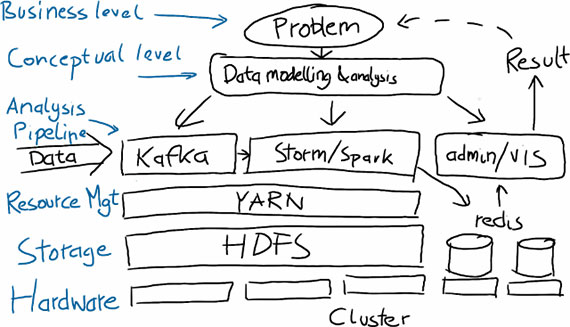"Data Show Podcast" entries

Building big data systems in academia and industry
The O'Reilly Data Show Podcast: Mikio Braun on stream processing, academic research, and training.
Mikio Braun is a machine learning researcher who also enjoys software engineering. We first met when he co-founded a real-time analytics company called streamdrill. Since then, I’ve always had great conversations with him on many topics in the data space. He gave one of the best-attended sessions at Strata + Hadoop World in Barcelona last year on some of his work at streamdrill.
I recently sat down with Braun for the latest episode of the O’Reilly Data Show Podcast, and we talked about machine learning, stream processing and analytics, his recent foray into data science training, and academia versus industry (his interests are a bit on the “applied” side, but he enjoys both).

An example of a big data solution. Source: Mikio Braun, used with permission.

The science of moving dots: the O’Reilly Data Show Podcast
Rajiv Maheswaran talks about the tools and techniques required to analyze new kinds of sports data.
Many data scientists are comfortable working with structured operational data and unstructured text. Newer techniques like deep learning have opened up data types like images, video, and audio.
Other common data sources are garnering attention. With the rise of mobile phones equipped with GPS, I’m meeting many more data scientists at start-ups and large companies who specialize in spatio-temporal pattern recognition. Analyzing “moving dots” requires specialized tools and techniques.
Subscribe to the O’Reilly Data Show Podcast
A few months ago, I sat down with Rajiv Maheswaran founder and CEO of Second Spectrum, a company that applies analytics to sports tracking data. Maheswaran talked about this new kind of data and the challenge of finding patterns:
“It’s interesting because it’s a new type of data problem. Everybody knows that big data machine learning has done a lot of stuff in structured data, in photos, in translation for language, but moving dots is a very new kind of data where you haven’t figured out the right feature set to be able to find patterns from. There’s no language of moving dots, at least not that computers understand. People understand it very well, but there’s no computational language of moving dots that are interacting. We wanted to build that up, mostly because data about moving dots is very, very new. It’s only in the last five years, between phones and GPS and new tracking technologies, that moving data has actually emerged.”